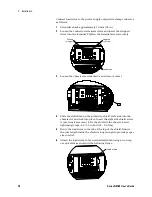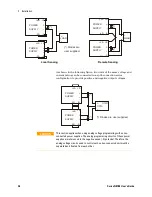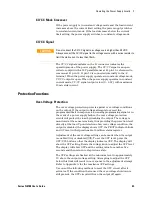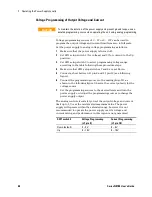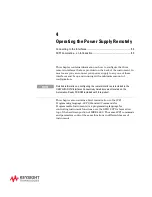
3
Operating the Power Supply Locally
40
Series N8700 User’s Guide
Turn-On Check-Out
Before Turn-On
Ensure that the power supply is configured as follows:
The unit is connected to the proper AC mains (see chapter 2).
The POWER switch is in the off position.
Sense connector pins 1 and 2 are jumpered; sense connector
pins 4 and 5 are jumpered.
All switches on Connector J2 are in the down position.
WARNING
SHOCK HAZARD
Be aware that hazardous voltages can be present on the
output terminals. Do not set the output voltage above 40 VDC during the turn-
on check-out procedure. Check to make sure that the startup mode is set to
Safe-Start (see page 44).
NOTE
Windows CE instruments (instruments manufactured starting in 2014) have a
different turn-on characteristic than previous units. Windows CE units may take
up to 30 seconds to initialize when they are turned on.
Constant Voltage Check
1
Turn the POWER switch on.
2
Turn the output on by pressing the OUT ON button. The green
OUT ON indicator should be illuminated.
3
The green CV indicator should also be illuminated. If the CC
indicator is illuminated, rotate the current knob until the CV
indicator becomes illuminated.
4
Rotate the voltage knob while observing the DC VOLTS display.
The output voltage should vary while the knob is turned. The
voltage range is from zero to the maximum rated output for the
power supply model.
OVP Check
1
Rotate the voltage knob and set the output voltage of the unit to
50% of its full-scale rating or 30 volts, whichever is lower.
2
Press the OVP/UVL button once so that the DC AMPS display
indicates OUP. The DC VOLTS display shows the OVP level.
3
Use the voltage knob and set the OVP level of the unit to 75% of
its full-scale voltage rating or 40 volts, whichever is lower.
4
Wait a few seconds until the DC VOLTS display returns to show
the output voltage.
5
Use the voltage knob and raise the output voltage of the unit until
it approaches the OVP setting. Check to make sure that the
output voltage cannot be set higher than the OVP setting.



